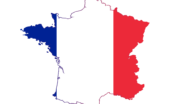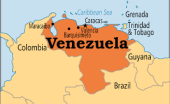So many memories, particularly of the years as neighbours on Rosemount Avenue, with shared activities, adventures and lively political discussions.…
Africa and water
Written by Diana Thebaud Nicholson // December 17, 2013 // Africa, Water // Comments Off on Africa and water
International Decade for Action ‘Water for Life’ 2005-2015 – Africa
Water’s crucial role in accomplishing the continent’s development goals is widely recognized. Africa faces endemic poverty, food insecurity and pervasive underdevelopment, with almost all countries lacking the human, economic and institutional capacities to effectively develop and manage their water resources sustainably.
Effect of West African dam projects on poor raises concerns
Three dam projects in West Africa are being touted as being critical to electrical power and food security to the region, writes Elias Ntungwe Ngalame. But advocates for the poor say little benefit will come to rural residents and that alternatives such as solar should be explored.
Samuel Nguiffo, coordinator of the Centre for the Environment and Development, a Cameroon-based nongovernmental organisation, acknowledged that Africa needs energy for its development, but said the social and environmental price of constructing big dams is often too high.
“People have to be displaced, communities along the project area have to sacrifice their land and livelihood for little or no benefits, and the natural environment (is) destroyed,” he said, citing a report by the International Union for Conservation of Nature that said Kandadji dam would displace some 38,000 people along the river.
Inequitable distribution of benefits can also sometimes spark conflicts that call into question the overall value of many dams in meeting water and energy needs, he added. Thomson Reuters Foundation (12/17)
African countries work toward agreement on Nile dam
Egypt, Ethiopia and Sudan are meeting this week in Khartoum to discuss Ethiopia’s Renaissance Dam and its impact on Nile River water resources, writes Elizabeth Arrott. Sudan had supported Egypt’s claim that water losses threaten its security, but Sudan now supports Ethiopia’s right to build the dam. Voice of America (12/9)
7 August
Namibia drought threatens thousands 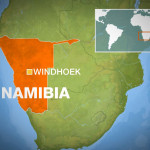
(Al Jazeera) Severe drought leaves 400,000 facing hunger, as government is criticised for failing to do enough to provide relief.
The government has been criticised for failing to do enough to provide relief to people during the worst dry spell to hit the country in decades. Al Jazeera meteorologist Richard Angwin said that Namibia is one of the driest countries in the world. Seasonal rains are very light and erratic at the best of times.
16 July
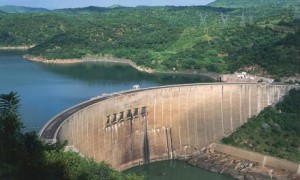 Kariba dam, hydroelectric dam on the Zambezi River, Zimbabwe. Photograph: Alamy
Kariba dam, hydroelectric dam on the Zambezi River, Zimbabwe. Photograph: Alamy
The World Bank is bringing back big, bad dams
A renewed focus on mega-dams will make matters worse in Africa and benefit companies, not people
(The Guardian) In the 1950s and ’60s, huge hydropower projects such as the Kariba, Akosombo and Inga dams were supposed to modernise poor African countries almost overnight. It didn’t work out this way. As the independent World Commission on Dams found, such big, complex schemes cost far more but produce less energy than expected. Their primary beneficiaries are mining companies and aluminium smelters, while Africa’s poor have been left high and dry.
The Inga 1 and 2 dams on the Congo River are a case in point. After donors have spent billions of dollars on them, 85% of the electricity in the Democratic Republic of Congo is used by high-voltage consumers but less than 10% of the population has access to electricity. The communities displaced by the Inga and Kariba dams continue to fight for their compensation and economic rehabilitation after 50 years.
15-22 June
FAO Highlights Inseparable Links Between Food and Water
Since food and water are so closely interlinked, there is a lingering fear based on the assumption, if there is no water, there will be no food.
The Food and Agriculture Organisation (FAO) underlines the strong links between the two when it declares that agriculture accounts for over 70 percent of global water use.
Meanwhile, the share of water available for agriculture is expected to decline to 40 percent by 2050, warns an FAO report released here for the agency’s 38thsession, currently [15-22 June] underway.
19 June
Water: Battle of the Nile
By Katrina Manson and Borzou Daragahi
Ethiopia’s $4.8bn plan to dam Africa’s longest river has infuriated states downstream
(Financial Times) Behind him, a coral-brown gash had been cut into the green hillside. Yellow Caterpillar earthmoving trucks rumbled across the construction site while the assembled dignitaries stood under a glaring sun, fanning themselves with brochures promoting the Grand Ethiopian Renaissance Dam project. … “This is about Egypt being weakened and Ethiopia becoming stronger in comparison,” says Cleo Paskal, a water security expert at Chatham House, the London think-tank.
Maaza Mengis: The Nile belongs to Ethiopia too
The increasing tensions with Egypt over the proposed dam reveal how fundamental the river is to both nations’ identity
(The Guardian) The Nile, at 6,700km, is the longest river in the world. It begins in Ethiopia and ends in Egypt. It moves counter to what one might expect, flowing upwards on the map. This, as much as anything, reflects the river’s mythological dimensions. It defies logic, its identity is as much a product of poetry as politics. … Despite the fact that 85% of the Nile originates in Ethiopia, we still associate the river with Cleopatra and King Tut, with pyramids and the sphinx, with sophisticated belief systems and advanced scientific knowledge. The Nile is a metaphor for Egypt. It is a geographic location as much as it is shorthand for one of the most innovative moments in world history. In popular imagination, it is as far removed from poverty as one can get. It is the opposite of devastation and privation.18 June
Egypt and Ethiopia agree to bridge dam divide
Foreign ministers try to quell tensions over Ethiopia’s plans to divert Blue Nile in controversial dam project.
(Al Jazeera) Ethiopia and Egypt have agreed to hold further talks on the impact of a huge Ethiopian dam project to quell tensions between the two countries over water-sharing.
14 June
Ethiopia ratifies Nile treaty in snub to Egypt
(Planet Ark) Ethiopia’s parliament unanimously ratified a treaty on Thursday that strips Egypt of its right to the lion’s share of the Nile river waters, raising the political temperature in a dispute between Cairo and Addis Ababa over the construction of a dam.
Ethiopia and five other Nile basin countries – Burundi, Kenya, Rwanda, Tanzania and Uganda – have now signed a deal effectively stripping Cairo of its veto, based on colonial-era treaties, over dam projects on the Nile, source of nearly all of Egypt’s water.
13 June
Egypt’s Limited Military Options to Stop an Ethiopian Dam Project
Ethiopia’s initiation of a dam project on the Blue Nile has quickly drawn the ire of Egypt, which is critically dependent on it as a source of much of the country’s freshwater needs.
While Egypt has struggled to attract diplomatic intervention on its behalf to thwart Ethiopia’s dam construction, tensions have reached the point where Egypt has suggested the use of force to keep the dam from potentially lowering the Nile’s water levels downstream to unacceptable levels. There will be serious international pressure to keep the dispute over the dam in the realm of diplomacy, but there are also fairly significant constraints on the physical possibility of an Egyptian military solution.
12 June
Ethiopia discards Egypt threats over Nile dam
Foreign ministry says it is not intimidated by Egypt’s “psychological warfare” and dam project will proceed.
11 June
Egypt warns Ethiopia over Nile dam
(Al Jazeera) President Morsi says “all options are open” in dealing with dam project that threatens Egypt with a water shortage.
Ethiopia’s $4.2 billion hydroelectric dam, which would be Africa’s largest, challenges a colonial-era agreement that had given Egypt and Sudan the lion’s share of rights to Nile water.
Experts estimate that Egypt could lose as much as 20 percent of its Nile water in the three to five years needed for Ethiopia to fill a massive reservoir.
Morsi’s speech reflected the importance of the Nile River to Egypt. It provides almost all of the fresh water to a country that is otherwise largely parched desert. As much as 85 percent of the Nile’s water comes from Ethiopia.
29 May
Ethiopia diverts flow of Blue Nile
Egypt and Sudan express concern over multi-billion dollar dam on Nile which violates colonial-era agreement.
1 March
Water – A Blessing and a Curse in Mozambique
(IPS) – As Mozambique tries to recover from the worst flooding here since 2000, experts have called for a national discussion on water management and how to maximise its usage in favour of long-term sustainable development. … Some 54 percent of Mozambique’s annual surface flow comes from outside the country and because of its geographical location it has always been vulnerable to natural disaster, particularly flooding, according to the Global Water Partnership Africa.
… The flooding, however, creates a deceptive impression of Mozambique’s water availability. According to the United Nations Environmental Programme, the availability of freshwater in Mozambique is expected to decrease by over half by 2025.
As water stress is expected to become an increasing problem, it has made experts question the feasibility of forestry projects that could affect the country’s water balance.
2012
16 August
China’s role in funding Ethiopian dam draws ire
(CMS) Ethiopia says construction of a dam along the Omo River will create needed electrical power for itself and Kenya, and channel water for food production. Environmentalists worry it could drain a Kenyan desert lake central to people’s livelihoods.
Kenyan environmental activists want the Industrial and Commercial Bank of China to hold off on a promise to invest $500 million in Ethiopia’s $1.7 billion Gibe III Hydro-electric Dam, which they say threatens Lake Turkana – the world’s largest permanent desert lake, and a crucial source of water for half a million people.
20 July
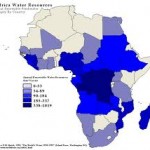 Vast aquifer found in Namibia could last for centuries
Vast aquifer found in Namibia could last for centuries
A newly discovered water source in Namibia could have a major impact on development in the driest country in sub-Saharan Africa.
(BBC) Estimates suggest the aquifer could supply the north of the country for 400 years at current rates of consumption.
Scientists say the water is up to 10,000 years old but is cleaner to drink than many modern sources.
Over the past decade the Namibian government have been trying to tackle the lack of a sustainable supply in partnership with researchers from Germany and other EU countries.
They have now identified a new aquifer called Ohangwena II, which flows under the boundary between Angola and Namibia.
As well as identifying the new water source a key aim for the researchers involved is to develop the capacity among young Namibians to manage their country’s water resources before the funding from the EU runs out.
10 July
Nairobi water ‘stolen for farms’ 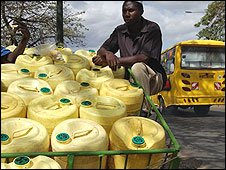
Authorities in Kenya’s capital say they have unearthed a syndicate stealing the city’s water to irrigate farms.
Nairobi City Council says nearly half the capital’s water was being diverted by dealers working with officials at the water distribution department.
20 April
‘Huge’ water resource exists under Africa
Scientists say the notoriously dry continent of Africa is sitting on a vast reservoir of groundwater.
(BBC) They argue that the total volume of water in aquifers underground is 100 times the amount found on the surface.
The team have produced the most detailed map yet of the scale and potential of this hidden resource.
Writing in the journal Environmental Research Letters, they stress that large scale drilling might not be the best way of increasing water supplies.
Across Africa more than 300 million people are said not to have access to safe drinking water.
Demand for water is set to grow markedly in coming decades due to population growth and the need for irrigation to grow crops.
2011
Baobab | Issue 62 | June 2011
Degradation of Mau forests threatens agriculture and Kenya’s economy
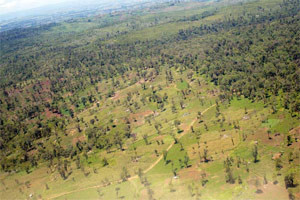 The role of trees in agricultural production and water catchment has become starkly apparent in Kenya following the now well known encroachment and degradation of the Mau forests complex. The complex is one of Kenya’s five water towers, the others being Mt. Kenya, Aberdare ranges, the Cherangani Hills and Mt. Elgon.
The role of trees in agricultural production and water catchment has become starkly apparent in Kenya following the now well known encroachment and degradation of the Mau forests complex. The complex is one of Kenya’s five water towers, the others being Mt. Kenya, Aberdare ranges, the Cherangani Hills and Mt. Elgon.
It is reported that the Mau forests complex forms the largest closed-canopy forest ecosystem of Kenya, as large as the forests of Mt. Kenya and the Aberdare ranges combined. Being one of the five water towers in Kenya and the single most important water catchment in Rift Valley and western Kenya, it is a natural asset of national importance.
It is also argued that forest complex biodiversity and habitats provide vital ecological services to the country, in terms of water storage; river flow regulation; flood mitigation; recharge of groundwater; reduced soil erosion and siltation; water purification; conservation of biodiversity; and; micro-climate regulation. Through these ecological services, the forests complex supports key economic sectors in Rift Valley and western Kenya, including energy, tourism, agriculture, and industries.

